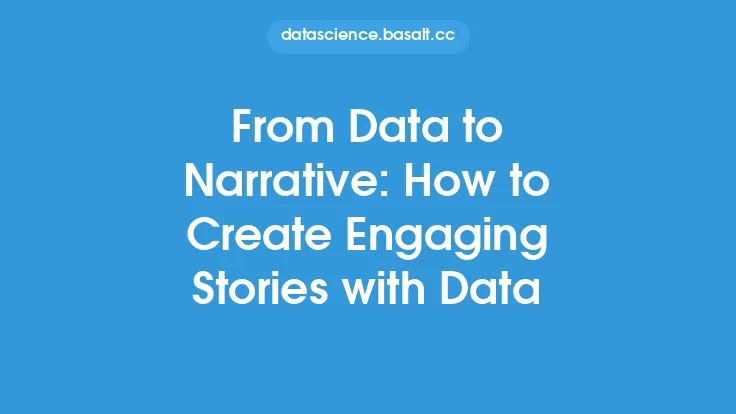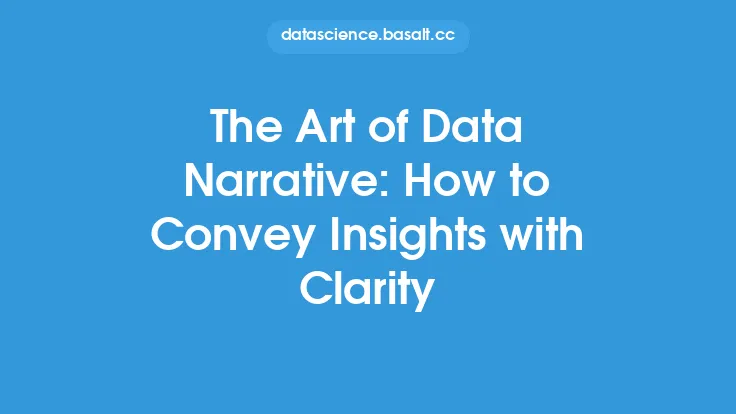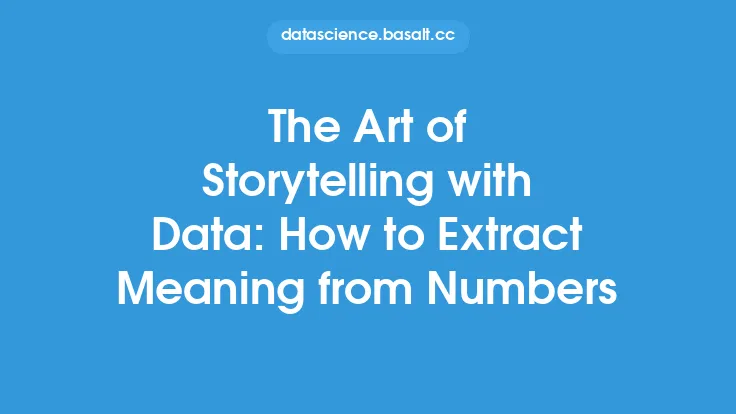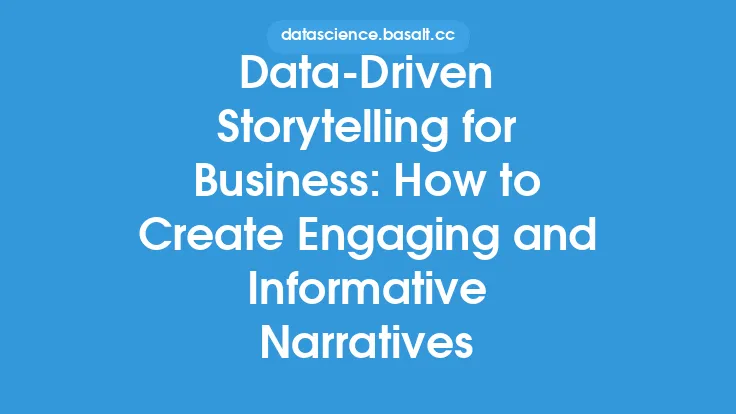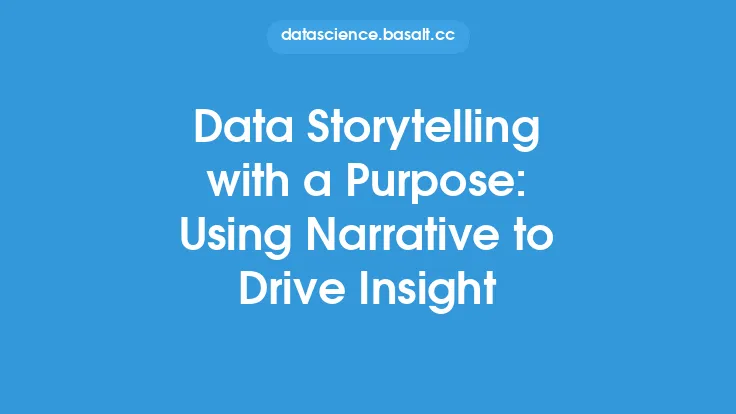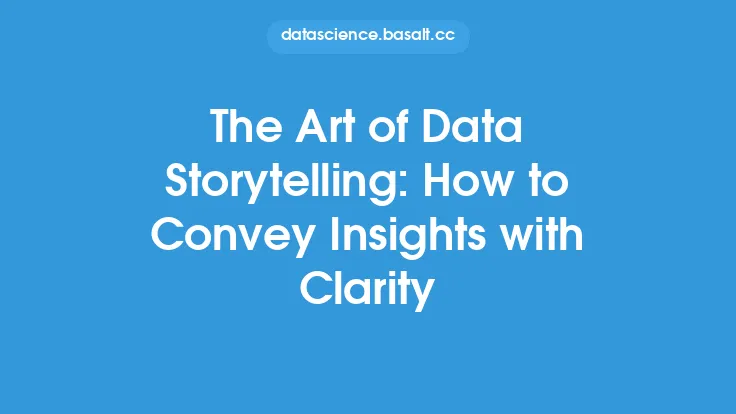The ability to create immersive stories with data is a highly sought-after skill in today's data-driven world. As the amount of data being generated continues to grow exponentially, the need to effectively communicate insights and findings from this data has become increasingly important. One of the most effective ways to do this is by using data-driven narrative techniques to create immersive stories that capture the audience's attention and convey complex information in a clear and concise manner.
Introduction to Data-Driven Narrative Techniques
Data-driven narrative techniques involve using data to tell a story that is both informative and engaging. This approach combines the use of data visualization, statistical analysis, and storytelling principles to create a narrative that is supported by evidence and insights from the data. The goal of data-driven narrative techniques is to create a story that is not only accurate and informative but also compelling and memorable. By using data to drive the narrative, storytellers can create a more immersive and engaging experience for their audience, making it more likely that the story will be remembered and acted upon.
The Importance of Data Quality and Preparation
Before creating a data-driven narrative, it is essential to ensure that the data is of high quality and properly prepared. This involves cleaning, transforming, and formatting the data to make it suitable for analysis and visualization. Data quality issues such as missing or duplicate values, outliers, and inconsistencies can significantly impact the accuracy and reliability of the narrative. Therefore, it is crucial to invest time and effort in data preparation to ensure that the data is accurate, complete, and consistent. This may involve using data preprocessing techniques such as data normalization, feature scaling, and data transformation to prepare the data for analysis.
Data Visualization and Storytelling
Data visualization is a critical component of data-driven narrative techniques. It involves using visual elements such as charts, graphs, and maps to communicate insights and findings from the data. Effective data visualization can help to create a clear and concise narrative that is easy to understand and interpret. There are several data visualization techniques that can be used to create immersive stories, including interactive visualizations, animated visualizations, and geospatial visualizations. Interactive visualizations, for example, allow the audience to explore the data in more detail, while animated visualizations can be used to show how the data changes over time. Geospatial visualizations, on the other hand, can be used to show how the data is distributed across different geographic locations.
Statistical Analysis and Modeling
Statistical analysis and modeling are also essential components of data-driven narrative techniques. They involve using statistical methods and models to identify patterns, trends, and relationships in the data. This can help to create a more nuanced and detailed narrative that is supported by evidence and insights from the data. There are several statistical analysis and modeling techniques that can be used to create immersive stories, including regression analysis, time series analysis, and machine learning algorithms. Regression analysis, for example, can be used to identify the relationships between different variables, while time series analysis can be used to forecast future trends and patterns. Machine learning algorithms, on the other hand, can be used to identify complex patterns and relationships in the data.
Crafting a Compelling Narrative
Crafting a compelling narrative is a critical component of data-driven narrative techniques. This involves using storytelling principles such as character development, plot structure, and conflict resolution to create a narrative that is engaging and memorable. The narrative should have a clear beginning, middle, and end, and should be supported by evidence and insights from the data. The use of anecdotes, examples, and case studies can also help to make the narrative more relatable and engaging. Additionally, the narrative should be tailored to the audience and should take into account their needs, interests, and level of understanding.
Best Practices for Creating Immersive Stories with Data
There are several best practices that can be used to create immersive stories with data. These include keeping the narrative simple and focused, using clear and concise language, and avoiding technical jargon and complex terminology. The use of visual elements such as images, videos, and animations can also help to make the narrative more engaging and memorable. Additionally, the narrative should be interactive and should allow the audience to explore the data in more detail. This can be achieved through the use of interactive visualizations, dashboards, and other interactive tools.
Common Challenges and Pitfalls
There are several common challenges and pitfalls that can occur when creating immersive stories with data. These include data quality issues, lack of clarity and focus, and insufficient context and background information. The use of too much technical jargon and complex terminology can also make the narrative difficult to understand and interpret. Additionally, the narrative should be tailored to the audience and should take into account their needs, interests, and level of understanding. Failure to do so can result in a narrative that is not engaging or memorable.
Future Directions and Trends
The field of data-driven narrative techniques is constantly evolving, and there are several future directions and trends that are worth noting. These include the use of artificial intelligence and machine learning algorithms to create more personalized and interactive narratives, the use of virtual and augmented reality to create more immersive and engaging experiences, and the use of natural language processing and generation to create more automated and efficient narrative creation. Additionally, the use of data-driven narrative techniques in fields such as education, healthcare, and finance is becoming increasingly popular, and is likely to continue to grow in the future.
Conclusion
Creating immersive stories with data is a highly effective way to communicate insights and findings from complex data sets. By using data-driven narrative techniques, storytellers can create a narrative that is both informative and engaging, and that captures the audience's attention and conveys complex information in a clear and concise manner. The key to creating immersive stories with data is to ensure that the data is of high quality and properly prepared, to use effective data visualization and statistical analysis techniques, and to craft a compelling narrative that is supported by evidence and insights from the data. By following these best practices and avoiding common challenges and pitfalls, storytellers can create immersive stories with data that are both memorable and impactful.
